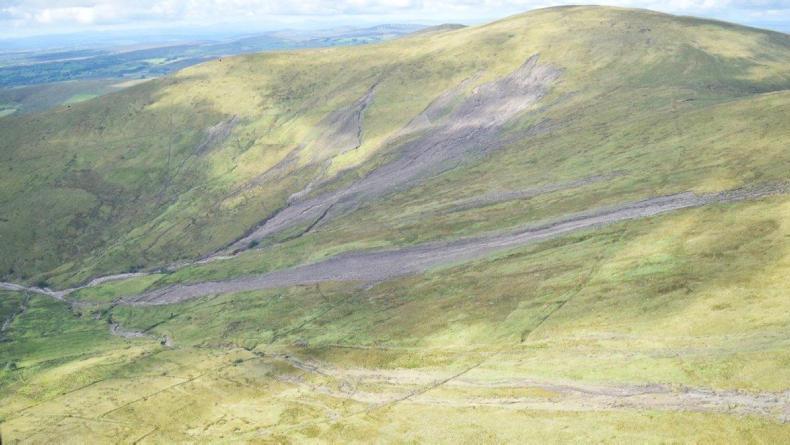Landslides that devastated farmland in the Glenelly Valley in Co Tyrone last August were a “one-in-3,000-year event,” local farmers were told on Thursday evening.
At an information event organised by DAERA, Dr Alan Dykes from Kingston University London said that 13 areas of landslides occurred in the valley on 22 August 2017, with some of these areas involving several individual landslides.
“Rainfall records show that ground was fairly wet before the storm. The nearest weather station shows that at least 50mm of rain then fell within three hours on 22 August. I think the actual rainfall in this local area was considerably higher than that, but we have no records,” he said.
Listen to "Cause and recovery of NW floods" on Spreaker.
Dykes said that as peat soils on higher ground in the Glenelly Valley became saturated, water could not pass through an impermeable iron pan soil layer around 1m below the surface. Landslides occurred in the mid slopes of mountain ground as the increasing pressure of water in the peat caused the saturated soils to move down the valley.
Ten events in 50 years
Many farmers who either had mountain land eroded by landslides or had lower ground covered in deposits from the landslides have been concerned that a similar event could occur in the future.
However, Dykes reassured the audience in Cranagh that it is extremely unlikely that this type of event will occur again in the area.
“There have only been 10 events similar to this in the whole of the British Isles in the last 50 years. It is not something that you are going to expect to see again,” the upland landslide specialist told farmers.
Rate of rainfall
Dykes pointed out that it was not the large volume of rain that caused the landslides, but the short space of time in which the volume of rain fell.
He acknowledged that climate change could mean it is increasingly likely that high rainfall depths will cause flooding in a given river every few decades, or even every few years. “By comparison, the probability of multiple landslides at any specific location is vanishingly small,” Dykes said.
He presented rainfall statistics which suggested that 50mm of rainfall within 24 hours in an area was a one-in-150-year event, whereas 50mm in three hours was a one-in-3,000-year event.
Dykes also told farmers that soils that were not eroded by the landslides last August will require an even higher rate of rainfall to move off in a landslide in the future.

Dr Alan Dykes speaking to farmers in Cranagh, Co Tyrone on Thursday evening.
His advice to farmers that had upland ground affected by the landslides was to let the land regenerate naturally in a process that will take several years.
DAERA officials at the event said that farmers with silt and peat deposits on lower-lying ground can incorporate the material into land once it dries out if it is under 50mm deep.
They recommend lifting deeper deposits of material and either storing it at a suitable place on the same farm or spreading the material with a manure spreader when it dries out.
Read more from the event in next week’s Irish Farmers Journal and at www.farmersjournal.ie.
More than 1,000ha damaged by floods in NI
Watch: Stormont deadlock limits flood aid options - DAERA
Claims for flooded land can be made in 2018
Watch: calls for Government support as receding floods leave devastated farms






 This is a subscriber-only article
This is a subscriber-only article










SHARING OPTIONS: